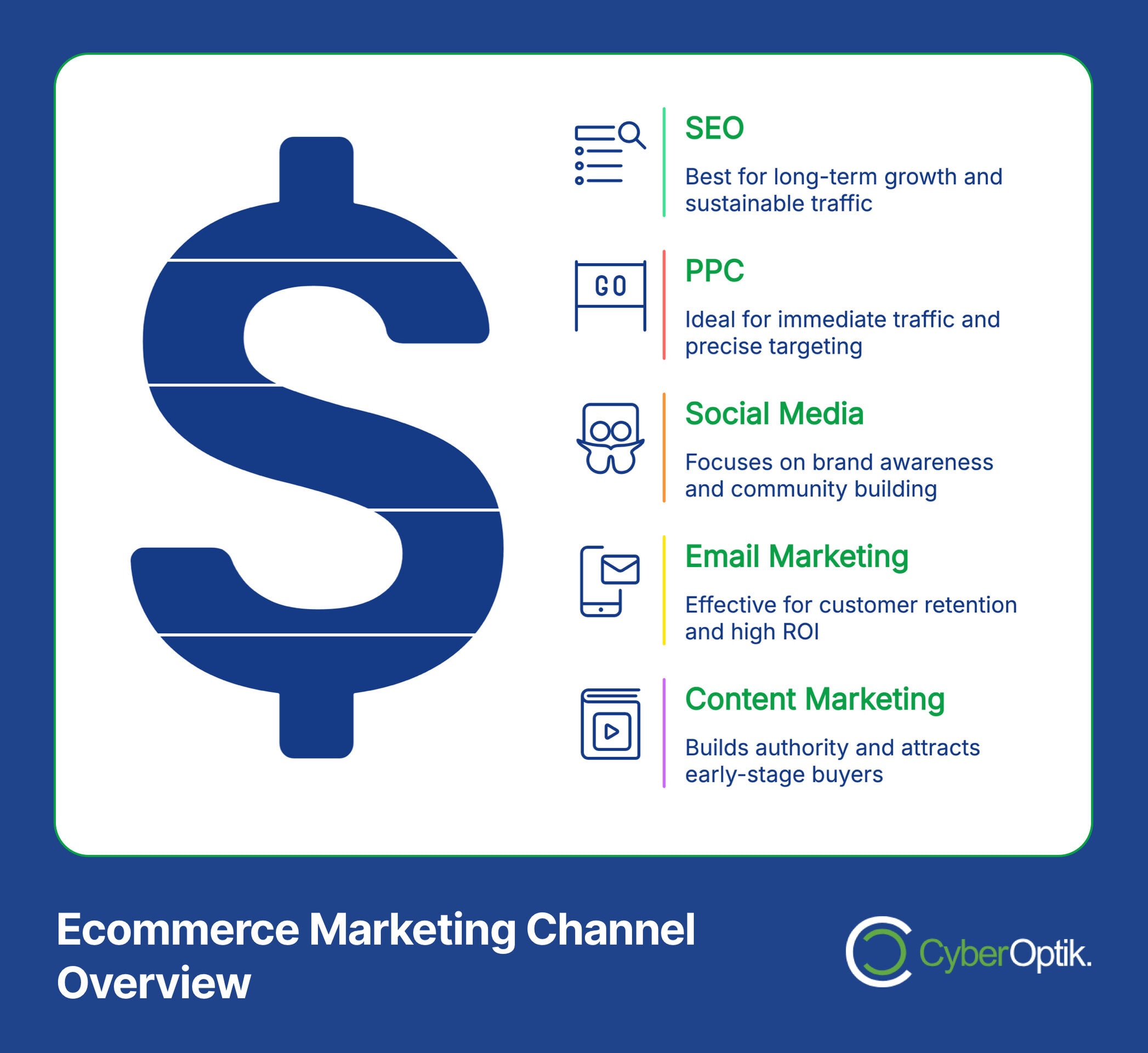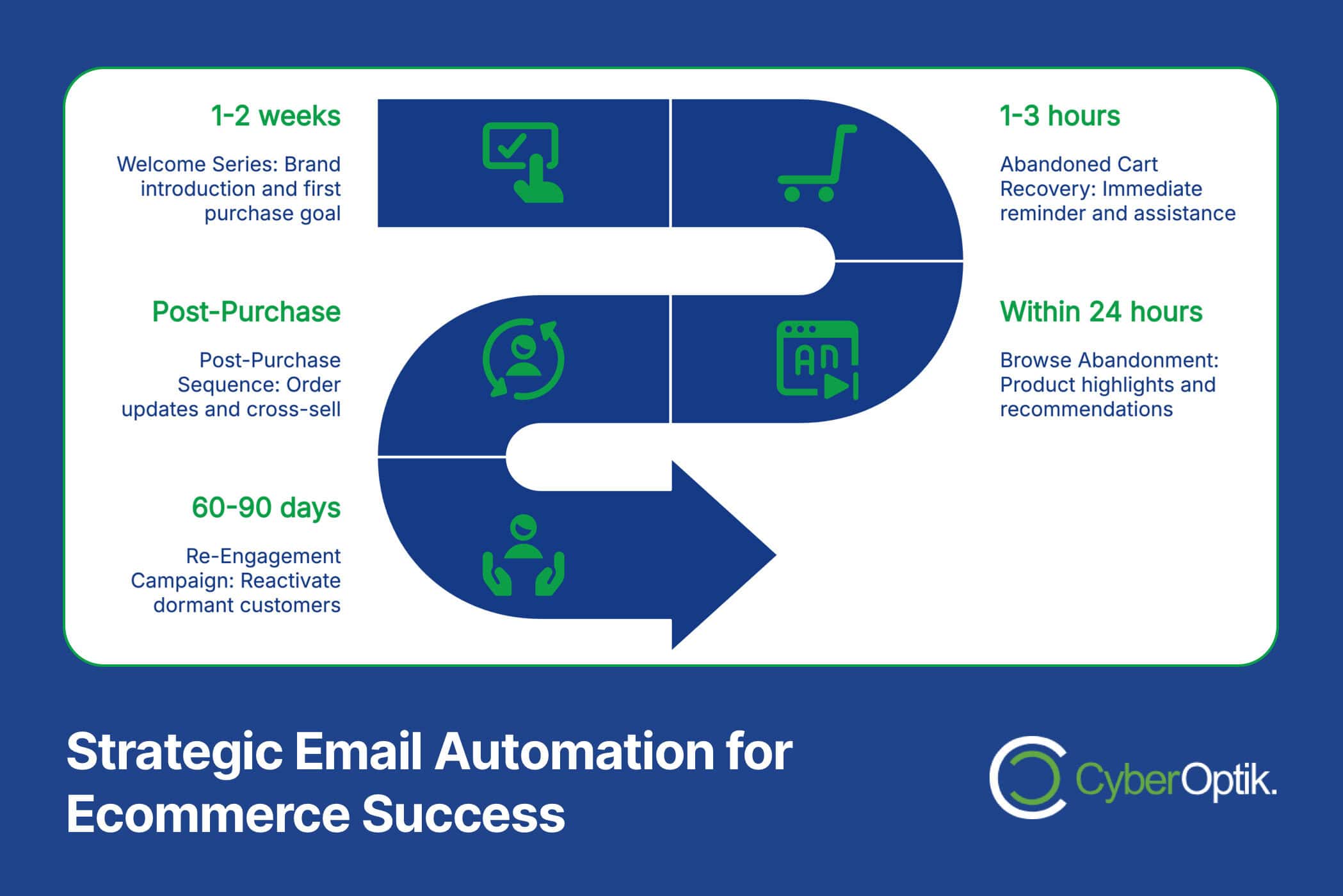Running a successful ecommerce business requires more than just great products. The digital marketplace grows more competitive each day. Without effective marketing strategies, even exceptional online stores struggle to attract visitors and generate sales. This challenge affects businesses across all industries.
We’ve worked with numerous Chicago businesses facing this exact problem. Their well-designed websites sat virtually invisible to potential customers. Through our experience helping these companies implement strategic marketing approaches, we’ve identified the most effective strategies for driving ecommerce traffic and increasing sales.
In this comprehensive guide, we’ll explore proven marketing strategies specifically for ecommerce businesses. You’ll discover practical approaches to improve visibility, attract qualified traffic, and optimize for conversions. Let’s begin with understanding today’s ecommerce landscape.
The Ecommerce Marketing Industry in 2025
The ecommerce market continues its rapid expansion. More consumers shop online than ever before. This growth creates both opportunities and challenges for online retailers trying to stand out in a crowded marketplace.
Digital marketing channels have evolved significantly in recent years. The most successful ecommerce businesses now employ multi-channel strategies that meet customers at various touchpoints. These integrated approaches deliver more consistent results than single-channel tactics.
The financial investment in ecommerce advertising reflects this evolution. In 2021, Amazon alone earned $31.2 billion from advertising revenue, nearly double YouTube’s revenue during that period. (Source: WSLS)
U.S. businesses continue to increase their advertising investment on platforms like Amazon. In 2022, U.S. ad spending on Amazon reached $13.5 billion, demonstrating the platform’s growing importance to marketers. (Source: Statista)

Understanding where to allocate your marketing budget becomes crucial for maximizing returns. Each channel offers distinct advantages depending on your specific business goals. The table below provides a comparative overview of the major marketing channels for ecommerce businesses.
| Marketing Channel | Best For | Typical ROI Timeline | Budget Requirement |
|---|---|---|---|
| SEO | Long-term growth, sustainable traffic | 3-6+ months | Medium-High |
| PPC/Paid Ads | Immediate traffic, product launches | Immediate-1 month | High |
| Social Media | Brand awareness, community building | 2-4 months | Medium |
| Email Marketing | Customer retention, repeat purchases | 1-2 months | Low-Medium |
| Content Marketing | Educational value, organic growth | 3-6+ months | Medium |
This channels overview helps you understand where to focus based on your specific business needs. Now let’s explore each major strategy in detail.
Understanding the Ecommerce Customer Journey
Effective marketing starts with understanding your customer’s path to purchase. The typical ecommerce journey includes several stages. Each stage offers unique opportunities for engagement and optimization.
Most customer journeys begin with need recognition. The potential customer realizes they need a product or solution. They then move to the research phase, exploring options through search engines, social media, and review sites. After narrowing their options, they compare specific alternatives before making a purchase decision.
Your marketing strategies must address each stage appropriately. Awareness-focused content performs differently than conversion-oriented material. By mapping your customer’s journey, you can create targeted content for each phase of their decision process.
Behavioral factors also influence purchase decisions. These include urgency, social proof, and perceived value. Strategic marketing addresses these psychological triggers at appropriate journey points. This approach maximizes conversion potential throughout the customer path.
Search Engine Optimization (SEO) for Ecommerce
SEO forms the foundation of sustainable ecommerce growth. A strong organic presence drives ongoing traffic without the continuous cost of paid advertising. For online stores, SEO delivers highly-targeted visitors actively seeking products like yours.
Ecommerce SEO differs from standard website optimization. Product and category pages need specialized approaches. Large inventories require strategic indexing plans. The competitive landscape demands more sophisticated keyword targeting.
Search engines evaluate ecommerce sites on several key factors. These include technical performance, content quality, user experience, and backlink authority. Each element requires specific optimization techniques tailored to ecommerce structures.
The most successful ecommerce sites prioritize SEO as a long-term strategic investment. While results take time to develop fully, the compound growth creates substantial business value. This approach complements faster-acting paid channels for comprehensive market coverage.
Technical SEO Elements for Ecommerce Success
Technical SEO creates the foundation for ecommerce search visibility. Without solid technical structure, even excellent content struggles to rank well. These factors directly impact both search engines and user experience.
Site speed significantly influences both rankings and conversions. Faster loading pages retain more visitors and earn better positions in search results. Mobile optimization has become non-negotiable as Google primarily uses mobile-first indexing for all websites.
The following technical elements prove particularly important for ecommerce success:
- Site architecture – Logical category structure and intuitive navigation paths
- URL structure – Clean, keyword-rich URLs for products and categories
- Indexation management – Strategic handling of product variants and filters
- Internal linking – Strategic cross-linking between related products and categories
- Schema markup – Product structured data to enhance search appearances
Beyond these foundational elements, ecommerce sites need specialized technical optimizations. These include pagination handling, faceted navigation management, and canonical tag implementation. Each addresses potential crawling or duplicate content issues common to ecommerce solutions.
Content Strategy for Ecommerce SEO
Content drives ecommerce SEO success beyond technical foundations. Effective product and category pages must balance sales messaging with SEO requirements. This dual focus challenges many online retailers.
Product pages need descriptive, unique content. Duplicate manufacturer descriptions harm rankings. Custom product details highlighting unique benefits and use cases improve both search visibility and conversion rates. Including specifications in proper HTML format helps search engines understand product attributes.
Category pages offer significant SEO opportunities. These pages should include relevant introductory content explaining the product collection. Strategic keyword integration in headers, product titles, and descriptions improves topical relevance. Supporting text should address common customer questions and selection considerations.
Blogs and resource sections complement product content. Educational articles addressing customer pain points build topical authority. Buying guides help customers make informed decisions while targeting valuable keywords. These content types attract top-of-funnel visitors who may later convert.
Paid Advertising Strategies for Ecommerce
Paid advertising delivers immediate traffic while SEO builds momentum. For ecommerce businesses, strategic ad campaigns can drive qualified visitors with high purchase intent. The right approach varies based on your products, audience, and business goals.
Digital advertising platforms offer increasingly sophisticated targeting options. This precision helps allocate budget to the most promising customer segments. Advanced measurement capabilities track performance from impression to purchase, enabling data-driven optimization.
What is PPC marketing and how does it apply to ecommerce? PPC stands for pay-per-click, a model where advertisers pay each time someone clicks their ads. For online stores, this approach offers immediate visibility with precise targeting capabilities. Product-focused campaigns require different structures than service-based advertising.
The major advertising channels for ecommerce include search engines (Google, Bing), social platforms (Facebook, Instagram), and marketplaces (Amazon). Each platform serves different customer intents and requires specialized approaches. Let’s examine marketplace advertising first, as it targets customers already in shopping mode.
Marketplace Advertising: Amazon and Beyond
Marketplace advertising places your products directly in front of active shoppers. Amazon leads this space with its sophisticated advertising platform. The company’s advertising revenue is projected to reach $94 billion in 2026, up from $37.74 billion in 2022, demonstrating the channel’s growing importance. (Source: SalesDuo)
In 2022, Amazon generated over $31 billion in advertising revenue globally, showing the platform’s tremendous growth as an advertising channel. (Source: Chris Turton Ecommerce)
Understanding Amazon’s advertising cost structure helps set realistic budgets. The table below outlines key cost considerations for Amazon advertising:
| Amazon Ad Type | Average CPC | Recommended Budget | Typical ACOS |
|---|---|---|---|
| Sponsored Products | $0.80-$1.20 | $25-$50/day minimum | 15-30% |
| Sponsored Brands | $1.00-$1.50 | $100/day minimum | 20-35% |
| Sponsored Display | $0.50-$0.80 | $100/day minimum | 25-40% |
| Amazon DSP | CPM based | $35,000 minimum | Varies |
Advertisers should also be aware of Amazon’s regulatory advertising fees in Canada, effective August 2024, which add costs tied to digital services taxes (DSTs) in several countries. (Source: SellerApp)
Performance metrics help gauge campaign effectiveness. The average cost-per-click (CPC) on Amazon Ads in 2025 is $0.98, up from $0.89 in early 2024. (Source: Ad Badger) Meanwhile, the average Advertising Cost of Sale (ACOS) for beginners is approximately 29%, with seasonal fluctuations between 26.8% and 34.59% in 2024.
Amazon’s ad business growth has been remarkable, generating $9.5 billion in Q3 2022 alone, surpassing competitors like Microsoft and Snap. (Source: Business Insider) This growth trajectory continues to attract both sellers and brands looking to capture market share.
Business size influences optimal advertising strategy. For small businesses with $500K-$1M in revenue, focusing on long-tail keywords and Sponsored Products with a target ACOS of 15-25% works well. Larger brands with $1M-$20M+ revenue should combine automatic and manual campaigns while prioritizing high-revenue products.
Beyond Amazon, other marketplaces like Walmart, eBay, and Etsy offer advertising options. Each platform has unique audience characteristics and advertising structures. A multi-marketplace approach reaches different customer segments while reducing dependence on a single platform.
Social Media Advertising for Ecommerce
Social media advertising excels at visual product promotion and targeted audience reach. Platforms like Instagram, Facebook, and Pinterest offer highly visual formats ideal for showcasing products. Advanced targeting capabilities match offers to users based on interests, behaviors, and demographics.
Platform selection should align with your audience demographics and product characteristics. Instagram and Pinterest work well for visually appealing consumer products. Facebook offers broader demographic reach and sophisticated targeting. LinkedIn performs better for high-value B2B products and services.
Recent platform developments impact advertising strategy. Major brands like Amazon and Apple have increased ad spending on X (formerly Twitter) in 2025, though overall brand investment remains below pre-2022 levels. (Source: Portada) This trend suggests selective opportunity on this platform for certain brand categories.
Ad formats significantly impact campaign performance. Video ads typically generate higher engagement than static images. Carousel formats allow multiple product presentations in a single ad unit. Collection ads create immersive shopping experiences without leaving the platform.
Remarketing to website visitors through social platforms drives higher ROI than traditional marketing channels. These campaigns remind interested shoppers about products they viewed but didn’t purchase. Dynamic product ads automatically show visitors the exact items they considered, creating a personalized advertising experience.
Social Media Marketing for Ecommerce Growth
Organic social media marketing complements paid advertising efforts. While advertising drives immediate traffic, organic social builds brand awareness and community. This approach nurtures relationships with existing customers while attracting new prospects.
Platform selection should align with your target demographic and content capabilities. Each platform demands different content types and posting frequencies. Resource constraints may limit how many channels you can effectively manage. Focus on quality presence on fewer platforms rather than poor execution across many.
The following table compares major social platforms for ecommerce marketing:
| Platform | Best Product Categories | Primary Audience | Content Focus |
|---|---|---|---|
| Fashion, Beauty, Home Goods | 18-34, Urban, Visual | High-quality lifestyle imagery | |
| Wide range | 25-54, Diverse demographics | Community, value content | |
| TikTok | Trending, Innovative products | 16-24, Trend-focused | Short, entertaining videos |
| Home, DIY, Fashion, Food | 25-44, Female-skewed | Inspirational, idea-driven | |
| B2B, Professional services | 25-64, Professional | Industry insights, expertise |
Content strategy should focus on value beyond product promotion. Educational content addressing customer problems builds authority. Behind-the-scenes content humanizes your brand. User-generated content provides authentic social proof while reducing content creation demands.
Posting consistency matters more than frequency. Abandoned social profiles harm brand perception. Creating a sustainable content calendar helps maintain regular presence without overwhelming resources. Quality consistently outperforms quantity in social engagement metrics.
Building an Engaged Community Around Your Products
Community building transforms one-time buyers into brand advocates. Engaged customers purchase more frequently and refer others. This strategy creates sustainable growth beyond immediate sales conversion.
User-generated content provides powerful social proof. Satisfied customers sharing product experiences influence potential buyers more effectively than brand messaging. Encourage content creation through hashtag campaigns, review incentives, and feature opportunities.
Influencer collaborations extend reach to relevant audiences. Micro-influencers (5,000-50,000 followers) often deliver better engagement rates than celebrity accounts. Authentic partnerships where the influencer genuinely uses and values your products perform best. Clear campaign goals and measurement frameworks ensure ROI from these investments.
Interactive content drives higher engagement than passive consumption. Polls, questions, contests, and challenges invite audience participation. These formats increase algorithm visibility while providing valuable customer insights. The engagement also strengthens community connections between customers and your brand.
Email Marketing for Ecommerce Success
Email marketing delivers the highest ROI of any digital channel for most ecommerce businesses. Direct inbox access creates opportunities throughout the customer lifecycle. From acquisition to retention, strategic email deployments drive significant revenue.
List building requires ethical, permission-based approaches. Pop-ups offering valuable incentives (discounts, guides, tools) convert visitors to subscribers. Post-purchase flows should always include subscription options. Content upgrades within blog posts attract readers interested in specific topics.
Segmentation dramatically improves campaign performance. Dividing your audience by purchase history, browsing behavior, and engagement levels enables targeted messaging. Geographic and demographic segments allow for localized offers and relevant content. Behavioral segments based on specific product interests drive higher conversion rates.

Automation creates scalable, timely customer communication. The following email workflows prove particularly valuable for ecommerce:
- Welcome series – Introduce new subscribers to your brand and products
- Abandoned cart recovery – Remind shoppers about items left in cart
- Browse abandonment – Re-engage visitors who viewed products without adding to cart
- Post-purchase sequence – Provide order updates, usage tips, and cross-sell recommendations
- Re-engagement campaign – Activate dormant subscribers and customers
Personalization extends beyond using the subscriber’s name. Dynamic content blocks display products based on browsing history. Recommendation engines suggest items based on purchase patterns. Send-time optimization delivers messages when individuals are most likely to engage. These approaches significantly lift open and conversion rates.
Cart Abandonment Recovery Strategies
Cart abandonment represents a significant revenue opportunity. The average online store loses over 70% of carts before checkout completion. Effective recovery strategies recapture a substantial portion of these potential sales.
Understanding abandonment reasons guides recovery approaches. Common issues include unexpected shipping costs, complicated checkout processes, and comparison shopping. Addressing these factors in recovery communications increases conversion likelihood.
Email timing significantly impacts recovery success. The first recovery email should arrive within 1-3 hours of abandonment while purchase intent remains high. A sequence of 2-3 emails spaced over 24-72 hours provides multiple recovery opportunities without becoming annoying.
Content and incentive strategy requires careful planning. The initial email often works best as a helpful reminder without discounts. Later emails may introduce escalating incentives if needed. Clear cart contents visuals, prominent checkout buttons, and customer service options should appear in all recovery communications.
Measuring and Optimizing Ecommerce Marketing Performance
Performance measurement enables data-driven optimization. Without proper tracking, marketing investments become speculative rather than strategic. Comprehensive analytics frameworks connect activities to outcomes across all channels.
Key performance indicators vary by channel and campaign objective. The table below outlines essential metrics for major ecommerce marketing activities:
| Channel | Traffic Metrics | Engagement Metrics | Conversion Metrics |
|---|---|---|---|
| SEO | Organic visits, Rankings | Pages/session, Bounce rate | Organic conversion rate, Revenue |
| Paid Search | Impressions, Clicks, CTR | Quality Score, CPC | ROAS, CPA, Conversion rate |
| Social Media | Reach, Impressions | Engagement rate, Shares | Click-through rate, Conversions |
| List growth, Open rate | Click-through rate | Revenue per email, Conversion rate | |
| Overall | Sessions, Traffic sources | Average order value | Conversion rate, Customer LTV |
Attribution models determine how conversion credit distributes across touchpoints. Last-click attribution assigns full credit to the final interaction before purchase. First-click models credit the initial touchpoint. Multi-touch models distribute value across the customer journey. The right approach depends on your sales cycle and marketing mix.
Regular performance reviews enable continuous improvement. Weekly checks identify immediate optimization opportunities. Monthly reviews reveal medium-term trends. Quarterly strategic assessments evaluate channel mix and resource allocation. This cadence balances tactical adjustments with strategic direction.
Conversion Rate Optimization Techniques
Conversion optimization improves results from existing traffic. Even small percentage improvements deliver significant revenue impact. This approach maximizes return from current marketing investments before scaling spend.
User experience directly impacts conversion rates. Site speed, navigation clarity, and mobile responsiveness influence purchasing decisions. Product imagery quality, description completeness, and specification clarity affect buyer confidence. Checkout simplicity determines abandonment likelihood.
Testing provides data-driven optimization direction. A/B testing different elements reveals what actually works rather than what should work theoretically. Successful ecommerce sites continuously test these elements:
- Product page layouts – Image size, description placement, add-to-cart prominence
- Pricing presentation – Discount display, shipping cost visibility, price comparison
- Call-to-action elements – Button text, color, size, and placement
- Checkout process – Step count, form fields, progress indicators
- Trust elements – Review placement, security badges, guarantee messaging
Heat mapping and session recording provide qualitative insights beyond quantitative data. These tools reveal how users actually interact with your site. Watching real shopping sessions often identifies friction points that analytics might miss. This qualitative data complements testing data for comprehensive optimization.
Implementing Your Ecommerce Marketing Strategy
Effective implementation requires thoughtful planning and resource allocation. Many marketing strategies fail not from poor concept but from inadequate execution. A structured approach increases success likelihood while maximizing resource efficiency.
Resource requirements vary significantly by channel and business size. In-house capabilities should align with strategic priorities. Outsourcing specialized functions often proves more cost-effective than building internal expertise for all channels. Hybrid approaches work well for many businesses, keeping strategic control in-house while leveraging agency or freelancer execution.
Technology infrastructure supports marketing execution. From ecommerce platforms to marketing automation tools, technical capabilities enable strategy implementation. Evaluate integration capabilities when selecting tools. Seamless data flow between systems improves both efficiency and effectiveness.
Implementation timelines should balance ambition with realism. Phased approaches allow for learning and adjustment. Building on successes creates momentum while minimizing risk. The following implementation sequence works well for many ecommerce businesses:
- Foundation building – Analytics setup, technical SEO, basic content
- Quick win activation – Email automation, remarketing, low-competition PPC
- Brand development – Content marketing, social presence, engagement building
- Scale and optimization – Expanded paid media, advanced SEO, personalization
- Innovation and differentiation – Unique marketing approaches, new channels
When developing your implementation timeline, remember that each marketing channel requires different resource commitments. For example, detailed research shows that for Amazon advertising, Sponsored Products campaigns require a minimum daily budget of $25-$50, with recommended campaign budgets between $500-$1,000. (Source: Jungle Scout)
Selecting the Right Partners for Ecommerce Success
Partner selection significantly impacts marketing outcomes. Whether agencies, freelancers, or technology providers, the right partners extend your capabilities while aligning with your business approach.
Agency selection criteria should include industry experience, technical capabilities, and cultural fit. Verify specific ecommerce expertise rather than general digital marketing background. Case studies demonstrating relevant results provide important validation. Clear communication processes and reporting transparency enable productive collaboration.
Technology selection requires similar diligence. Platform limitations can constrain marketing execution. Integration capabilities determine data flow and automation potential. Scalability supports business growth. Support quality affects implementation success and ongoing operations.
Partner evaluation metrics ensure accountability and value. Define clear KPIs for each relationship. Regular performance reviews identify both successes and improvement areas. Data-based discussion replaces subjective assessment. This approach maintains productive relationships while ensuring return on investment.
Conclusion
Effective ecommerce marketing requires a multi-channel approach tailored to your business goals, products, and target audience. By implementing the strategies outlined in this guide, you can increase traffic, improve conversion rates, and drive sustainable sales growth.
Remember that success comes from consistent execution rather than constant strategy shifts. Focus on building strong foundations before pursuing advanced tactics. Measure results diligently and optimize based on data rather than assumptions.
As you develop your ecommerce marketing plan, we’re here to help. Our team specializes in creating integrated digital strategies that deliver measurable results for online retailers. Contact us to discuss how we can support your ecommerce marketing goals.




